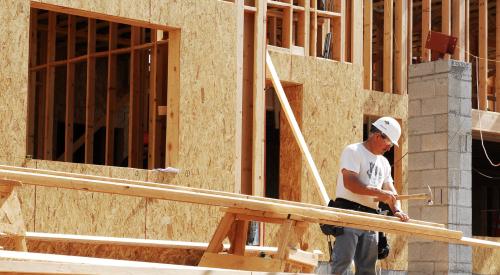Throughout the history of production home building, trade contractors have competed to secure work largely on the basis of price and the promise that they will provide skilled craftspeople, quality installation, and timely performance—until now.
What Has Changed for Home Builders Hiring Trade Contractors?
A seismic change has taken place in the home building industry, namely that builders now compete to gain commitments from trade partners instead of the other way around. The scarcity of skilled labor for construction jobs has created a serious, and perhaps permanent, deficit in available skilled craftspeople to meet the needs of new-home demand and production across the country.
In November, the Home Builders Institute (HBI), the educational arm of the National Association of Home Builders (NAHB), estimated that the overall construction industry, including residential, commercial, industrial, and other sectors, needs approximately 750,000 workers per year for the next three years to keep up with projected expansion, based on NAHB’s analysis of data from the Bureau of Labor Statistics—a dire situation that will be very difficult to reverse.
Let’s face it: Today’s workforce of young adults would much prefer to design websites from home than to work outside in the cold or extreme heat in difficult or dangerous conditions for relatively low pay. Attracting workers to the home building industry has never been so challenging.
So, how are home builders, who are now competing for those scarce resources, supposed to get their homes built on time and with a high standard of quality? How do they get to the front of the line as trade partners allocate those shrinking resources? The answer is simple: provide conditions that allow trades to be profitable.
The best builders have figured out how to do it. And while the formula may be simple to understand, it’s likely difficult to implement, as it requires a seismic shift in builders’ relationship with trades.
RELATED
- HBI President Ed Brady’s Call to Action to Solve the Construction Industry’s Labor Shortage
- Are Your Trade Relationships Strategic or Transactional?
- Project Manager Workloads: How Much Is Enough?
Steps to Take for Solving Your Labor Crisis
Here’s a list of the factors that can make the difference between profit and loss, gleaned from literally hundreds of conversations I’ve had and heard across dozens of focus groups conducted with trade partners across the country.
1. Tighter scopes of work
Too often, a home builder’s scope of work is vague or out of date, lacking the detail trades need for understanding specifically what they’re expected to deliver. (Hint: A scope of work that says, “Install drywall,” is not sufficient!) And when unclear scopes are debated, the trade invariably loses the argument, and then the trade has to do more than they bargained for (or bid on) at the expense of their profitability.
2. Clear, comprehensive construction documents
Incomplete or inaccurate blueprints cause errors and rework. Poor version-management results in the use of dog-eared, red-lined prints stored on pickup truck dashboards that are a surefire way to ensure incorrect installations. And who pays to correct them? Trades, which further erodes their profits on the job.
3. Reliable schedules
Trades consistently bemoan the “worthless” schedules provided by home builders, resulting in “dry runs” where their crews arrive to find a home not ready for them and then stand around until the builder or their boss finds them another jobsite to work on. Dry runs cost a lot of money, for both you and for your trade partners.
4. Ready homes
“Almost ready” homes are not good enough. When trades have to return to install the three interior doors or cabinets that were missing at the initial installation, they lose money (and you lose credibility). Home readiness means 100% home readiness … but tell that to a superintendent who just wants to get something—anything—done in the home, even if it means a return trip to complete the job!
Home readiness also means an empty home, not one shared with an upstream trade because the builder is behind schedule. It also means a clean home, not the unsafe pigsty trades often find waiting for them.
5. Paying on time
Yes, many builders face cash flow issues, particularly as cycle times increase and their closings lag behind their need for cash to pay bills. But remember: Your trades have payroll to meet, too.
There are other issues, but these are the primary situations I see that are caused by builder inefficiencies that cost their trades money and profitability—funds they can use to hire and train more people—not to mention the negative impact on the construction schedule, customers, and your profits and reputation, as well.
RELATED
- Close Relations: Ways Builders Can Work Well With Trades
- 7 Steps to Quality Homes (It's All About Process)
Better Process Management for Better Trade Relations and Greater Profitability
I’ve often pointed out that home building companies don’t actually build anything. They are process management companies relying on 20-plus other companies to build homes on their behalf. If the builder’s processes are poorly designed or executed, they create conditions in the field that make profitability more difficult for their business partners to achieve. It’s that simple.
If a home builder can’t provide clear scopes of work, complete and accurate construction documents (including customer selections), reliable schedules, and trade-ready homes (among other needs), their trade partners move them to the back of the line, sending crews only when their efficient builder clients have already gotten the crews they need.
Why Not All Home Builders Are Feeling the Labor Crunch
I hear from the efficient, effective, process-focused home builders that they aren’t really feeling the labor crunch. Somehow, they get the crews they need, with the skills they need, to build their homes on time and with high quality. There’s really no mystery as to why.
This doesn’t mean you shouldn’t evaluate your chosen trade contractors for capacity, the skill level of their crews, their commitment to quality, and their commitment to you before you award them a contract. You should always do your due diligence, no matter the labor shortages. But you’ll fail to maintain trades’ commitment if your own house is not in order.
The solution to your labor crisis is simple: be the best builder in your marketplace, earn the right to get trades’ “A” crews on Monday, and let your competitors scramble to keep up. After all, you’re now competing for their business, at least for the foreseeable future.













